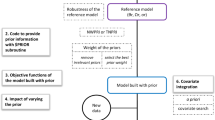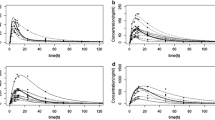Abstract
A few approaches for handling baseline responses are available for use in pharmacokinetic (PK)-pharmacodynamic (PD) analysis. They include: (method 1—B1) estimation of the typical value and interindividual variability (IIV) of baseline in the population, (B2) inclusion of the observed baseline response as a covariate acknowledging the residual variability, (B3) a more general version of B2 as it also takes the IIV of the baseline in the population into account, and (B4) normalization of all observations by the baseline value. The aim of this study was to investigate the relative performance of B1–B4. PD responses over a single dosing interval were simulated from an indirect response model in which a drug acts through stimulation or inhibition of the response according to an Emax model. The performance of B1–B4 was investigated under 22 designs, each containing 100 datasets. NONMEM VI beta was used to estimate model parameters with the FO and the FOCE method. The mean error (ME, %) and root mean squared error (RMSE, %) of the population parameter estimates were computed and used as an indicator of bias and imprecision. Absolute ME (|ME|) and RMSE from all methods were ranked within the same design, the lower the rank value the better method performance. Average rank of each method from all designs was reported. The results showed that with B1 and FOCE, the average of |ME| and RMSE across all typical individual parameters and all conditions was 5.9 and 31.8%. The average rank of |ME| for B1, B2, B3, and B4 was 3.7, 3.8, 3.3, and 5.2 for the FOCE method, and 4.6, 4.3, 4.7, and 6.4 for the FO method. The smallest imprecision was noted with the use of B1 (rank of 3.1 for FO, and 2.9 for FOCE) and increased, in order, with B3 (3.9-FO and 3.6-FOCE), B2 (4.8-FO; 4.7-FOCE), and B4 (6.4-FO; 6.5-FOCE). We conclude that when considering both bias and imprecision B1 was slightly better than B3 which in turn was better than B2. Differences between these methods were small. B4 was clearly inferior. The FOCE method led to a smaller bias, but no marked reduction in imprecision of parameter estimates compared to the FO method.
Similar content being viewed by others
References
Aarons L, Baxter C, Gupta S (2004) Pharmacodynamics of controlled release verapamil in patients with hypertension: an analysis using spline functions. Biopharm Drug Dispos 25: 219–225
Comets E, Mentre F, Grass P, Kawai R, Marbach P, Vonderscher J (2003) Population pharmacodynamic analysis of octreotide in acromegalic patients. Clin Pharmacol Ther 73: 95–106
Furuya A, Nozawa M, Gotoh J, Jingu S, Akimoto M, Higuchi S, Suwa T, Ogata H (2002) Pharmacokinetic and pharmacodynamic analysis of TS-943, a selective non-peptide platelet glycoprotein-IIb/IIIa (GPIIb/IIIa) receptor antagonist, using a nonlinear mixed effect model in dogs. J Pharm Pharmacol 54: 921–927
Hugh BM, Frey N (2004) Population PK and PK/PD analyses of an enzyme inhibitor in healthy volunteers. In: PAGE. Abstracts of the Annual Meeting of the Population Approach Group in Europe, Sweden
Karlsson MO, Wade JR, Loumaye E, Munafo A (1998) The population pharmacokinetics of recombinant- and urinary-human follicle stimulating hormone in women. Br J Clin Pharmacol 45: 13–20
Liesenfeld K, Stangier J, Garnett C, Tillmann C, Troconiz I, Lee H, Schaefer H (2005) PK/PD-modeling (PK/PD) and clinical trial simulation (CTS) of early clinical data of a new oral direct thrombin inhibitor (Dabigatran Etexilate). In: PAGE: Abstracts of the Annual Meeting of the Population Approach Group in Europe, Spain
Ramakrishnan R, Cheung WK, Wacholtz MC, Minton N, Jusko WJ (2004) Pharmacokinetic and pharmacodynamic modeling of recombinant human erythropoietin after single and multiple doses in healthy volunteers. J Clin Pharmacol 44: 991–1002
Togawa A, Tanaka T, Nagashima S, Keta H, Kobayashi Y, Nishikawa Y, Yanai M, Tanaka H (2004) A comparison of the bioequivalence of two formulations of epoetin alfa after subcutaneous injection. Br J Clin Pharmacol 58: 269–276
Zingmark PH, Edenius C, Karlsson MO (2004) Pharmacokinetic/pharmacodynamic models for the depletion of V(beta)5.2/5.3 T cells by the monoclonal antibody ATM-027 in patients with multiple sclerosis, as measured by FACS. Br J Clin Pharmacol 58: 378–389
Silber HE, Jauslin PM, Frey N, Gieschke R, Simonsson US, Karlsson MO (2007) An integrated model for glucose and insulin regulation in healthy volunteers and type 2 diabetic patients following intravenous glucose provocations. J Clin Pharmacol 47: 1159–1171
Sheiner LB (2003) NONMEM Tips #16—April 2, 2003—Modeling a “baseline” component and an additive “drug” component. http://www.huxley.phor.com/nonmem/nm/99apr022003.html. Accessed 13 Jan 2006
Mordenti J, Cavagnaro JA, Green JD (1996) Design of biological equivalence programs for therapeutic biotechnology products in clinical development: a perspective. Pharm Res 13: 1427–1437
Schindel F (2000) Consideration of endogenous backgrounds in pharmacokinetic analyses: a simulation study. Eur J Clin Pharmacol 56: 685–688
Sun YN, Jusko WJ (1999) Role of baseline parameters in determining indirect pharmacodynamic responses. J Pharm Sci 88: 987–990
Beal SL, Sheiner LS (1994) NONMEM user’s guide. San Fransisco: NONMEM project group. University of California at San Fransisco
Lindbom L, Pihlgren P, Jonsson EN (2005) PsN-Toolkit–a collection of computer intensive statistical methods for non-linear mixed effect modeling using NONMEM. Comput Methods Programs Biomed 79: 241–257
Dayneka NL, Garg V, Jusko WJ (1993) Comparison of four basic models of indirect pharmacodynamic responses. J Pharmacokinet Biopharm 21: 457–478
Author information
Authors and Affiliations
Corresponding author
Electronic supplementary material
Below are the Electronic supplementary materials
Rights and permissions
About this article
Cite this article
Dansirikul, C., Silber, H.E. & Karlsson, M.O. Approaches to handling pharmacodynamic baseline responses. J Pharmacokinet Pharmacodyn 35, 269–283 (2008). https://doi.org/10.1007/s10928-008-9088-2
Received:
Accepted:
Published:
Issue Date:
DOI: https://doi.org/10.1007/s10928-008-9088-2




